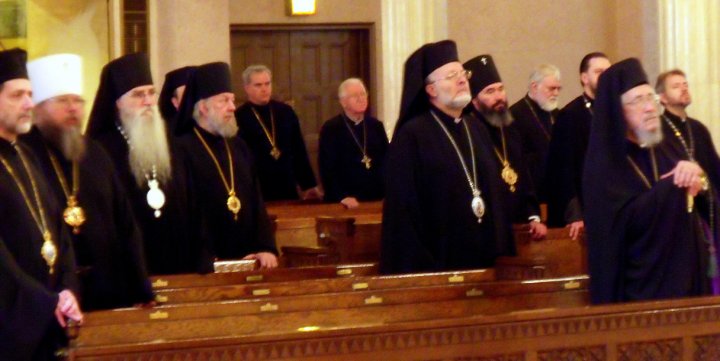
Hierarchs of the Episcopal Assembly of North and Central America: Bp. Jerome is the fourth fully visible face from left, and Abp. Justinian is four to the right of him
The reader may be interested to take a look at some eyewitness accounts of the recent Episcopal Assembly published by the ROCOR from three of the Russian bishops serving in North America, Abp. Justinian (MP USA), Bp. Job (MP Canada) and Bp. Jerome (ROCOR). (One of the more notable elements of the Episcopal Assembly is that it is the first major pan-Orthodox that the ROCOR bishops attended together since the reconciliation with Moscow in 2007.)
Also, Bp. Mark (Antiochian) sent a letter to his clergy with some of his own reflections on the meetings.
Notable too was the fact that the OCA hierarchs communed with bishops from both the EP and ROCOR. While this was not concelebration – the Liturgy was served by the Rev. Dr. Frank Marangos, Holy Trinity Cathedral (GOA) Dean alone – it showed clearly the unity of faith between the hierarchs of jurisdictions that have been on opposite side of varying issues over the years. That was a bold, mature move on the part of the EA – acknowledging the common faith as well as the canonical anomalies that have arisen from historical circumstances and pastoral requirements in the so-called Orthodox Diaspora (cf. the Message of the Holy Synaxis at the Phanar [October, 2008] in Istanbul).
I have also seen a picture in the altar at Holy Trinity Cathedral clearly showing Met. Jonah and other hierarchs vested and ready to commune. Not sure of the link. Would be interesting to note who was communing. Bp Jerome mentions communing at that Liturgy, as did all of the OCA bishops present, according to the press release.
Truly, “Behold, how good and pleasant it is when brothers dwell together” (Psalm 132:1).
I didn’t think to take roll on who was communing or even who was present. But no particular pattern struck me (e.g., everyone from a certain jurisdiction not communing, etc.). Of course, I can’t name them all on sight, either.
It’s important to make the distinction that the hierarchs were vested with stole and omophorion only, i.e., not serving together, but communing only. (You wrote “vested,” so I just wanted to expand on that for other readers who may not have been present.)
To be honest, if they had wanted to serve together, they would have needed a bigger church! But I imagine doing that may well be a long time off, if only because of the quagmire it would currently be to figure out who would stand in what order. Someday, though, I hope.
Good to clarify those things. Yes, it was not concelebration, but communing together publicly is an important step in recognizing the true Orthodoxy of all present. (You wouldn’t believe how much confusion there is – maybe purposefully in some circles – over whether the OCA is ‘non-canonical’ and thus ‘graceless’ or ‘schismatic’ vs. its autocephaly simply being unrecognized by a majority of autocephalous churches. This should clear that up.)
I think the order of the bishops present would likely follow the accepted order at the EA, which you rightly noted places the OCA last according to the OCA’s own diptychs rather than as an overly autonomous part of the Russian delegation, which would be more in keeping with the EP’s view of the OCA.
It has been my understanding that the EP did not view the OCA as either an autocephalous Church, nor as a part of the Moscow Patriarchate. The term I’ve often heard is “canonical anomaly.” Based on my reading of the EP’s view, the OCA is in a sort of canonical no-man’s land. They’re most certainly canonical, in the sense that they are fully Orthodox, but their specific ecclesiastical status is ambiguous.
On the EA itself, I found these words, from Bishop Jerome, to be particularly appropriate:
“The most important thing was that we were all together. Some people may ask, ‘What was the topic?’, or ‘What issues were you going to discuss?’ But I reply that the most important issue is, will we able to have this Pan-Orthodox hierarchal conference or not? And as it turns out, we could, and this means a great deal.”